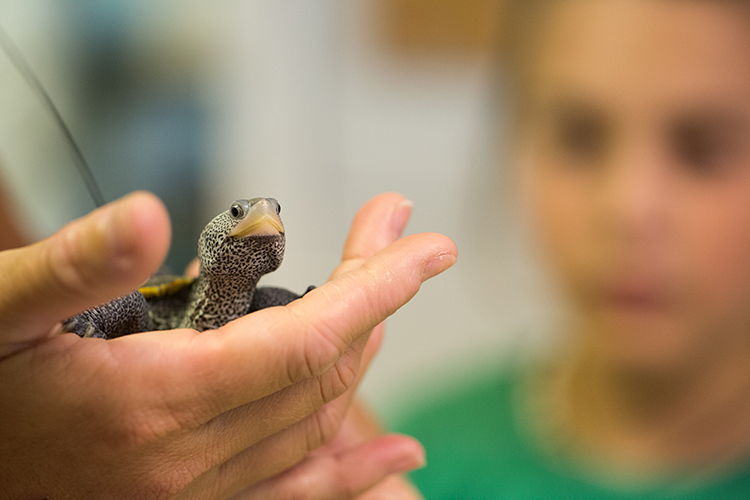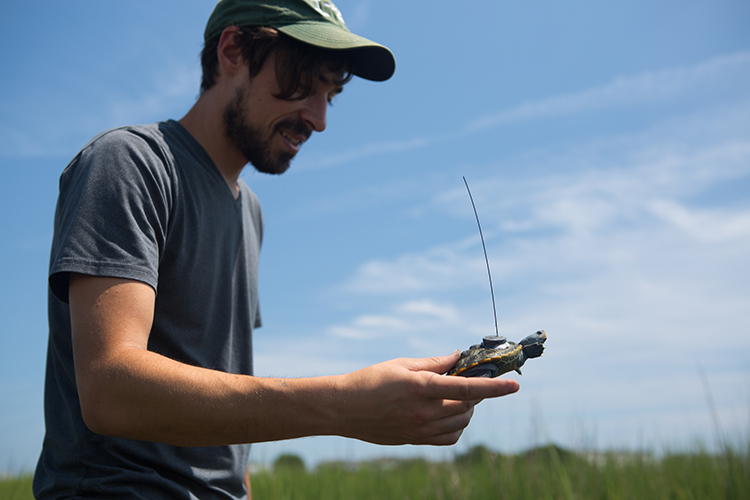Listen to an audio version of this story
For more audio from The Walrus, subscribe to AMI-audio podcasts on iTunes.
In August 2014, a padded FedEx envelope arrived at the Calgary International Airport. It had been shipped from an address in Levittown, Pennsylvania, and on the customs form it had been labelled “Book.” As it was being sorted, a customs agent saw the package move. Inside the envelope was a slim cardboard box with holes along its sides. Inside that box were two small fabric pouches with duct-taped edges. An agent carefully opened the pouches into a plastic mail-carrying bin. Golf ball–size baby turtles emerged, crawling toward corners, scrambling over one another’s shells, and shuffling up the box’s walls. There were eleven turtles in total. There was no food or water. Sheldon Jordan, as director general of wildlife enforcement for Environment and Climate Change Canada (ECCC), oversees all wildlife trafficking cases in the country. Everything about the package, he says, hinted at “just how big of a project” the investigation into where the turtles had come from and who had shipped them would be.
The hatchlings, all less than a year old, were Malaclemys terrapin, more commonly known as diamondback terrapins. They are native not to Canada but to a coastal fringe of territory along the Eastern Seaboard, from Massachusetts to Texas. Terrapins are hard to count, and no accurate population survey has ever been completed. Scientists say it is not possible to quantify the speed and scale of terrapin decline, but anecdotal evidence and small-scale assessments point to decreasing numbers. In 2019, the International Union for Conservation of Nature (IUCN) changed the species’ status from “near threatened” to a more serious “vulnerable.”
Canada and the US are signatories of the Convention on International Trade in Endangered Species of Wild Fauna and Flora, which requires an Appendix II permit to ship live turtles internationally. After the package of terrapins was discovered, the US Fish and Wildlife Service (USFWS) scanned its import/export database for the person named on the padded envelope as the shipper: Dave Sommers. There was no history of permits filed under that name. An anonymous informant—referred to in court documents as CPI-444—later called the Virginia-based offices of the USFWS’s international arm and mentioned the name Dave Sommers. Not only was he shipping turtles illegally, reported the informant, Sommers was collecting them illegally too.
Shortly afterward, a formal joint investigation between Canadian and American authorities was launched, something Jordan says occurs only a handful of times a year in cases of wildlife crime. Previous joint efforts, says Jordan, have convicted poachers of Alaska’s famous brown bears and a black-market importer of exotic Caribbean fish. The parcel of turtle hatchlings would come to reveal much more than just who had sent them: it would act as the first bread crumb in a trail from the Calgary airport to a New Jersey swamp to exotic pet collections in China, exposing a network far larger than one person and one padded envelope.
New Jersey’s coastal marshlands are home to diamondback terrapins and where Dave Sommers poached hatchlings and collected eggs from nests.
Before terrapins were poached for pets, they were eaten. They were a staple of the diets of some Indigenous people: terrapin is an adaptation of the Algonquin torope. Slave-holders in the American South once fed them to enslaved people. By the late nineteenth century, the turtles had become a delicacy, served at fine restaurants in a heady soup balanced with raisin-coloured sherry. President William Taft was known to enjoy the soup for White House dinners. Following centuries of sustainable turtle harvesting by Indigenous people, the young country’s love of the soup almost did the species in. According to NPR, America’s Prohibition era and the unavailability of sherry may have been the one thing that saved terrapins from extinction.
Symbolically, the turtle endured. In 1933, the University of Maryland informally adopted the terrapin as a mascot, named Testudo. Terrapins became a symbol of the Grateful Dead after their 1977 album, Terrapin Station. But terrapins themselves were in a sort of hiding. Roger Wood, professor emeritus of zoology at Stockton University, in New Jersey, describes how terrapins’ biology and depleted numbers resulted in a whole generation of fishers and boaters rarely seeing the turtles. They lived quietly in New Jersey’s pungent coastal marshes, burrowed in the java-coloured soils. A few females would appear on land in the summer, to dig holes for their eggs, but only after spending eight years growing into their egg-laying phase, which may explain why the terrapin rebound took so long.
Around the mid-1970s, Wood started seeing terrapins during his ecological studies. He was fascinated by their tolerance for both fresh and salt water, unique in the turtle world. Wood started the first New Jersey–based long-term study of terrapins and, in 1989, launched a roadkill tracking program with the Wetlands Institute, a local conservation organization. The institute rescues terrapins found in distress and returns them to the wild. It also records deaths, often of turtles found crushed along roads as humans and turtles are pushed closer together each year by coastal development. “We usually average 500” deaths per year, says Brian Williamson, a research scientist at the institute. Since most terrapins wandering onto highways are females looking to nest, this tally is an imperfect pulse-taking of southern New Jersey’s terrapin population. By 2019, the IUCN noted that the global population trend was “decreasing.” Williamson says scientists aren’t even sure how terrapins move around in coastal marshes, so he occasionally glues a temporary pencil-length antenna onto the shell of a rescued turtle to study its movement.
In China, one terrapin with a particularly desirable shell pattern fetched $24,000 (US).
Baited blue-crab traps, which attract and often drown turtles, were once considered the biggest threat to terrapins. Wood invented a device to solve this problem, which New Jersey now requires when crabbing in certain areas. But there’s little Wood, Williamson, or the institute can do on their own to address the rising threat of terrapin poaching. While some pet stores sell captive-bred diamondback terrapins, it is illegal in most US states to take them from the wild or disturb their nests. Prized for their unusual speckle patterns and colour variations—which are unique to each turtle, like a fingerprint—diamondback terrapins have a market price that varies based on their markings and where they are sold. At pet shops in Canada and the US, they often cost a few hundred dollars each. But, in parts of Asia, they can go for much more: in China, one terrapin with a particularly desirable shell pattern fetched $24,000 (US).
The picture that has emerged of the terrapin black market resembles a sinister web, connecting the overlooked marshes fringing America’s coastal vacation lands with buyers around the world. A series of recent turtle-poaching cases initiated a slew of laws in states across the Eastern Seaboard, including in New Jersey, which even shut down terrapin harvesting for subsistence food in 2016. In an article in the Philadelphia Inquirer, a New Jersey wildlife official referred to a 2014 confiscation of over 500 poached female terrapins as a “wake-up call.” In the Atlantic City Press, local “turtle hunter” Frank Mazzeo made it clear that the demand was coming from abroad. “Just because nobody around here eats them [anymore] doesn’t mean there isn’t a market for them.”
After the parcel of terrapin hatchlings was intercepted at the Calgary airport, Dave Sommers became the centre of a USFWS investigation called Operation Common Denominator, which ramped up in the summer of 2017. First, Sommers was duped into selling five different shipments of terrapins to undercover USFWS agents posing as out-of-state buyers. In an email to one undercover agent, Sommers warned that the terrapins were “kinda snippy.” The turtles arrived stuffed in white tube socks and bound with duct tape.
With a judge’s approval, USFWS agents attached GPS trackers to the two cars parked in Sommers’s driveway. Special agent Ryan Bessey tailed Sommers on trips into the lime-green marsh grass surrounding Great Bay Boulevard, a rare ribbon of coastal wilderness along New Jersey’s postcard shoreline. One evening, Bessey counted fifty-two freshly dug holes after observing Sommers. The excavations seemed identical to twelve disturbed terrapin nests that Sommers had admitted to raiding three weeks earlier, when two New Jersey Division of Fish and Wildlife officers caught him red-handed in a nature preserve after dark. The officers had confiscated the eggs and given Sommers a citation. According to the agents’ GPS tracker, Sommers returned to the very same spot two nights later. It was a break for investigators. “He’s told, ‘This is illegal—you can’t do this,’” says Bessey. “Basically, he didn’t skip a beat.”
Bessey’s information gathering culminated on July 15, 2017. Just after midnight, he crept into a wooded municipal park outside Sommers’s home and watched him sitting in his garage, the door open, carefully pulling eggs from white buckets, holding each up to a flashlight, and checking for the silhouetted turtle embryo inside, like a jeweller inspecting the quality of a diamond. That night, Sommers “candled,” as the process is called, eighty-five eggs. Three nights later, Bessey watched Sommers perform the same ritual, candling 188 eggs until 4 a.m. This time, though, the agent lying around twenty metres away caught the act on video.
In July 2017, Dave Sommers was filmed “candling” turtle eggs he had collected—inspecting them with a flashlight—by an undercover US Fish and Wildlife Service special agent. (US Fish and Wildlife Service)
On October 24, federal agents arrived at Sommers’s home and executed a search warrant. Inside, they found 3,442 diamondback terrapin hatchlings crawling over one another in large plastic bins. Those hatchlings alone, the US agents estimated, would be worth about $32,049 on the illegal American pet market and upward of $427,320 on the global market.
According to court documents, Sommers walked around his kitchen, making a cup of tea and chatting with the agents while they sifted through well-organized papers. They found a FedEx shipping label for the 2014 package Sommers had sent to Canada. Sommers voluntarily spoke with the agents for over an hour. He described how he had taken all the turtles from New Jersey and stated that he knew he was breaking the law. (Sommers later requested the suppression of the evidence collected and his statements made over tea, claiming they were obtained in violation of his constitutional rights. A court denied his request.)
Twenty-four hours after Sommers was arrested, Bessey drove a trailer to the salty backwaters of a New Jersey marsh. Around midmorning, he met Williamson, a New Jersey state police officer, and the college-age son of a colleague in the USFWS. All three had answered last-minute phone calls to assist an impromptu return of animals to the wild. Bessey says a “love of wildlife” that began with Rambo, a childhood pet turtle, had drawn him to work in this field. After the seizure at Sommers’s house, Bessey secured the necessary federal and state approvals to release the whole lot back into the marsh around Great Bay Boulevard.
When Bessey opened the trailer door, Williamson recoiled. “Quite a cocktail,” he recalls of the smell, like low tide infused with dog food. Squirming inside dozens of plastic bins were the thousands of hatchlings found in Sommers’s home. “I had never seen that many turtles at once in my life,” Williamson says.
The USFWS rarely returns poached animals to their habitats. Trafficked animals typically can’t be released into the wild because of concerns about spreading diseases and introducing invasive species, so most find placement in zoos, sanctuaries, or aquariums—arrangements that are far from ideal. “It was the first time that I was actually putting wildlife back into the wild,” Bessey says. Without expert guidance, he had assumed that the release would play out like the nature documentaries he had seen of baby sea turtles marching into the waves. He had envisioned “turning over coolers and letting them scurry into the marsh.” Bessey laughs. “After talking with Brian, I realized that, yeah, no, that wouldn’t be a good idea.” Diamondback terrapins are not like the sea turtles popularized in Planet Earth and Finding Nemo. Williamson hatched a different plan: hour after hour, they hand placed each turtle back into the marsh from where it had come.
The eleven turtles that had arrived in Canada, however, had a markedly different fate—even with the close collaboration between ECCC and the USFWS on cases of animal trafficking across the border. The same year the terrapin package was discovered, a Canadian man was intercepted at the Detroit–Windsor land border with fifty-one baby turtles duct-taped to his legs. Twenty-seven-year-old Kai Xu admitted to shipping turtles to China to help pay for tuition at the University of Waterloo, according to the CBC, and was sentenced to fifty-seven months in US prison. Catching a thief with turtles in his pants was a win for both countries, but it was also very lucky. “Each country is the other’s largest trading partner, and it’s the same when it comes to wildlife,” says director general Jordan, who collaborates regularly with his counterparts in the US. “The amount of work that is required to do an in-depth investigation is actually mind-boggling.” Both countries are limited by staff and resources, with ECCC having around 100 agents to investigate, coordinate with other countries, and place confiscated animals in the best possible homes throughout Canada.
The hatchlings rescued at the Calgary airport were temporarily put in the care of the Calgary Zoo, where one of them soon died. The surviving ten were handed back into the care of ECCC, which placed them at Reptile World, a zoo then based in Drumheller, an hour’s drive outside of Calgary. But, less than a year later, Reptile World was shuttered after an investigation by the Society for the Prevention of Cruelty to Animals uncovered that the heating system had failed in the middle of an Alberta winter and many of the cold-blooded animals had nearly frozen to death. Authorities seized more than a hundred animals, including the trafficked terrapins, and placed them in the Greater Vancouver Zoo—on the opposite side of the continent from where they originated. Other facilities rejected the terrapins: as a non-native species, they held little educational value, and their story as the product of wildlife smuggling was not one many wanted to highlight.

In February 2019, Sommers pleaded guilty to the illegal smuggling of protected turtles, both within the US and to Mexico and Canada. He was ordered to pay $250,000 (US) and was sentenced to six months in prison. In court documents, the Department of Justice noted an estimate of how many terrapins Sommers had trafficked: approximately 13,000 hatchlings, which it clarified was likely a gross underestimation.
Sommers was once a newspaper reporter, and his familiarity with the press made him deeply cautious about what he said on the record pertaining to his case. He had worked at the Trentonian, a New Jersey daily, in the 1990s—he says he has interviewed both Bill Clinton and Mike Tyson—and then, after a short hiatus, again in the early 2000s, according to a profile the newspaper ran after his arrest. The newspaper quoted many former staff writers about Sommers’s dogged journalistic style, using adjectives like gritty and hard-nosed. According to former colleagues, Sommers had been so committed to pursuing tough stories that they thought he would be glad to know his former place of employment was covering his indictment. “He would be disappointed if we didn’t go after this story,” said Jeff Edelstein, a former columnist.
Was Sommers simply poaching and selling to collectors or was he somehow connected to a larger organized network?
His former colleagues also noted Sommers’s “weird obsession” with turtles. Sommers says he sold terrapins in the pet trade for nearly fifteen years, and he claims that he has saved more turtles than he has sold. Perhaps, early on, Sommers’s business operated in a grey space between legal and illegal, where states still allowed the taking of some turtles from the wild as pets while severely restricting small-scale sales. But the rules changed. The US government believes that the country is now the world’s second-largest supplier of protected turtles to the illegal global market. A question has floated around Sommers since his arrest: Was he simply poaching and selling to collectors in the US and Canada or was he somehow connected to a larger organized network?
Despite Sommers’s claims that he never sold anything to anybody in China, investigators recovered PayPal statements from his house that included transactions with buyers in Canada, Mexico, and China. His pricing also directly aligned with the demand of the illegal markets in Asia. New Jersey terrapins exhibit two colourings: lighter skin with bold markings on their heads or a more uniform darker-grey skin. Turtles with light faces, the “concentric phenotype,” are worth more in the Asian markets. Sommers’s prices reflected that distinction. Breeding produces a mix. Poaching, on the other hand, ensures an abundance of light-coloured turtles. “If you’re out and able to selectively poach the individuals,” says Bessey, “then your chances are greater that you’re going to get the more desirable phenotype.”
Furthermore, around the same time as Sommers’s guilty plea, a team of Royal Malaysian Police and US federal agents intercepted a twenty-four-year-old medical student at Kuala Lumpur International Airport. Kang Juntao, a Chinese citizen, was accused of breaking US laws and international treaties related to money laundering and animal trafficking totalling $2.2 million dollars. He was extradited to the US. Trademarks of his operation included binding the hatchlings with duct tape and stuffing them into socks for transit. According to an affidavit written by Bessey, Kang instructed go-betweens, including young Chinese nationals attending American colleges, to “conceal the turtles in socks and mislabel the packages to avoid detection by customs authorities.”

On October 6, 2021, Kang was sentenced to thirty-eight months in prison. During his hearing, the prosecutor named one of his go-betweens as William Gangemi Jr., who was sentenced to two years’ probation in early 2020 for his role in a US-based smuggling ring. Gangemi cooperated with authorities by offering information on people he bought turtles from—one of whom was Dave Sommers. “The box is 10″ by 12″ by 3″ deep,” Sommers wrote Gangemi in the winter of 2014, according to emails Gangemi shared with authorities and obtained through a freedom of information request. “That easily fits 40 of these large baby diamondbacks.”
On the surface, Sommers was a solitary silhouette in the marsh, deeply knowledgeable of terrapin movements and the sandy contours of the best nesting spots; he seemingly poached by himself with efficiency and sold the turtles online as “Dave—PA.” “Sommers was as close to a one-man shop as we ever saw,” says Ryan Connors, a trial attorney for the US Department of Justice who was involved in both Sommers’s and Kang’s turtle-trafficking cases. But that doesn’t mean the products of Sommers’s shop didn’t end up in other markets and other hands—as elements of an illicit global ecosystem that includes poachers, smugglers, pet owners, and collectors. “We saw all different sorts of buyers purchasing from Sommers,” Bessey says, from “sophisticated, organized traffickers” to people who “just wanted a turtle.” Sommers maintains that he has always been just a hobbyist who loves turtles.
“What is native and mundane to [some], like a box turtle that you see in your backyard, is exotic and interesting to people overseas,” says Williamson, the biologist. “It has a certain allure.” That allure can distract from much-needed conversations about an animal’s conservation or welfare, as we’ve seen time and time again, from Barnum and Bailey’s circus elephants to Netflix’s Tiger King. The failure to fathom one’s own disappearing wildlife—especially less glamorous or charismatic animals—may be explained by an inability to envision the script flipped. Perhaps that was behind Sommers’s thinking too. He once expressed dismay about the plight not of terrapins but of a species exotic to him: the white rhino.
The last time I spoke with Sommers, before he declined to participate further in this story, his soft spot for journalists still showed in the jargon he used when asking about my reporting. In the Trentonian article about Sommers, a long-time colleague described him as a reporter who “didn’t stop until he got every morsel out of” a story. I can’t help but wonder if a part of him was rooting for me to find more morsels in this story. A few morsels still live in a wildlife sanctuary in Ontario.
I finally tracked down the turtles that Sommers tried to mail to a buyer in Canada. They had eventually ended up at Little Ray’s Nature Centre, in the care of Paul “Little Ray” Goulet. Over the past two decades, Goulet says, he has cared for thousands of reptiles seized by Canadian authorities from the illegal pet trade. He has legally repatriated several trafficked alligators back to US soil, and he is trying to do the same with the marooned terrapins so “they can have educational value for communities within their home range.” Because of international laws, this is an uphill mission, even with the unique collaboration between American and Canadian authorities to combat wildlife trafficking across the border. Most likely, the surviving terrapins will be with Goulet for the rest of his life. “Biologists don’t know how long these turtles actually live,” he says. “Some estimates put their lifespan at around fifty years. My three teenage sons will probably be taking care of these American turtles long after I’m gone.”




